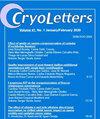Potential of fructans as natural cryoprotectant agents in plant cryopreservation: concept validation on Arabidopsis thaliana L.
IF 1
4区 生物学
Q3 BIOLOGY
引用次数: 0
Abstract
BACKGROUND Today, synthetic chemicals are used in vitrification solutions for cryopreservation studies to mimic natural cryoprotectants that supply tolerance to organisms in nature against freezing stress. In the case of plants, PVS2, containing glycerol, dimethyl sulfoxide (Me2SO), ethylene glycol and sucrose, is considered as the golden standard for successful cryopreservation. However, Me2SO can generally cause toxicity to certain plant cells, adversely affecting viability after freezing and/or thawing. Hence, the replacement (or substantial reduction) of Me2SO by cheap, non-toxic and natural cryoprotectants became a matter of high priority to vitrification solutions or reducing their content gained escalating importance for the cryopreservation of plants. Fructans, sucrose derivatives mainly consisting of fructose residues, are candidate cryoprotectants. OBJECTIVE Inspired by their protective role in nature, we here explored, for the first time, the potential of an array of 8 structurally different fructans as cryoprotectants in plant cryopreservation. MATERIALS AND METHODS Arabidopsis thaliana L. seedlings were used as a model system with a one-step vitrification method. PVS2 solutions with different Me2SO and fructan contents were evaluated. RESULTS It was found that branched low DP graminan, extracted from milky stage wheat kernels, led to the highest recovery (85%) among tested fructans with 12.5% Me2SO after cryopreservation, which was remarkably close to the viability (90%) observed with the original PVS2 containing 15% Me2SO. Moreover, its protective efficacy could be further optimized by addition of vitamin C acting as an antioxidant. CONCLUSION Such novel formulations offer great perspectives for cryopreservation of various crop species. Doi.org/10.54680/fr24410110512.果聚糖作为天然低温保护剂在植物低温保存中的潜力:拟南芥的概念验证
背景如今,用于低温保存研究的玻璃化溶液中使用了人工合成的化学物质,以模仿自然界中能使生物体耐受冷冻应激的天然低温保护剂。就植物而言,含有甘油、二甲基亚砜(Me2SO)、乙二醇和蔗糖的 PVS2 被认为是成功冷冻保存的黄金标准。然而,Me2SO 通常会对某些植物细胞产生毒性,影响冷冻和/或解冻后的存活率。因此,用廉价、无毒和天然的低温保护剂替代(或大幅减少)Me2SO 成为玻璃化溶液的当务之急,或减少其含量在植物低温保存中的重要性与日俱增。果聚糖是主要由果糖残基组成的蔗糖衍生物,是候选的低温保护剂。目的受果聚糖在自然界中的保护作用的启发,我们在此首次探索了 8 种结构不同的果聚糖作为低温保护剂在植物低温保存中的潜力。结果发现,从乳熟期小麦籽粒中提取的支链低密度禾本科聚糖在冷冻保存后的回收率(85%)在 12.5% Me2SO 的测试果聚糖中最高,与含有 15% Me2SO 的原始 PVS2 观察到的存活率(90%)非常接近。此外,通过添加作为抗氧化剂的维生素 C,还可进一步优化其保护功效。Doi.org/10.54680/fr24410110512.
本文章由计算机程序翻译,如有差异,请以英文原文为准。
求助全文
约1分钟内获得全文
求助全文
来源期刊

Cryo letters
生物-生理学
CiteScore
1.80
自引率
10.00%
发文量
50
审稿时长
1 months
期刊介绍:
A bimonthly international journal for low temperature sciences, including cryobiology, cryopreservation or vitrification of cells and tissues, chemical and physical aspects of freezing and drying, and studies involving ecology of cold environments, and cold adaptation
The journal publishes original research reports, authoritative reviews, technical developments and commissioned book reviews of studies of the effects produced by low temperatures on a wide variety of scientific and technical processes, or those involving low temperature techniques in the investigation of physical, chemical, biological and ecological problems.
 求助内容:
求助内容: 应助结果提醒方式:
应助结果提醒方式:


